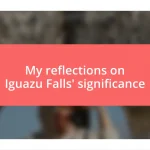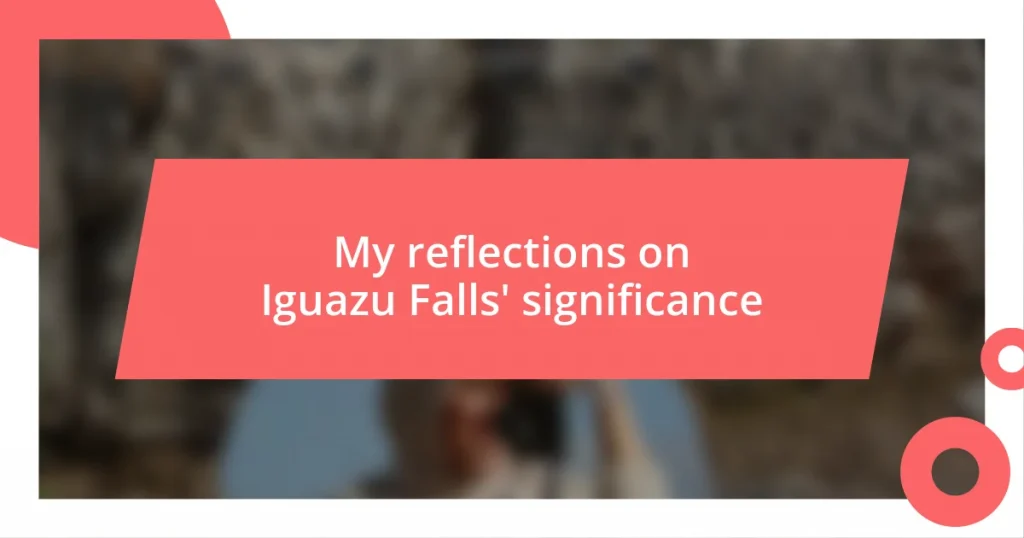Key takeaways:
- Iguazu Falls is a breathtaking natural wonder with over 275 individual falls, rich in cultural significance and ecological diversity.
- The historical importance of Iguazu includes its reverence among the Guarani people and its designation as a UNESCO World Heritage Site, highlighting its global cultural and environmental value.
- Conservation efforts at Iguazu focus on sustainability, education, and community involvement, ensuring the balance between tourism and environmental preservation for future generations.

Introduction to Iguazu Falls
Iguazu Falls, straddling the border between Brazil and Argentina, is not just a natural wonder; it’s an awe-inspiring testament to the power of nature. I still remember the moment I first laid eyes on the thundering cascades, feeling an almost overwhelming sense of insignificance yet exhilaration at being in the presence of such beauty. Have you ever experienced a place that made you rethink your connection to the world around you?
What’s fascinating about Iguazu is its sheer size—measuring around 1.7 miles long, it includes over 275 individual falls that collectively create a magnificent spectacle. Standing there, I felt the mist on my face and was enveloped by the symphony of roaring water. It’s hard to believe that something so grand exists outside the realm of imagination.
The falls are not only a visual feast; they’re also steeped in cultural significance and ecological diversity. Exploring the surrounding rainforest, I found myself entranced by the rich flora and fauna, which added layers of depth to the experience. How often do we encounter places rich in history, where each rock and tree seems to have a story to tell? This interplay of nature and culture makes Iguazu Falls a profound destination worth exploring.
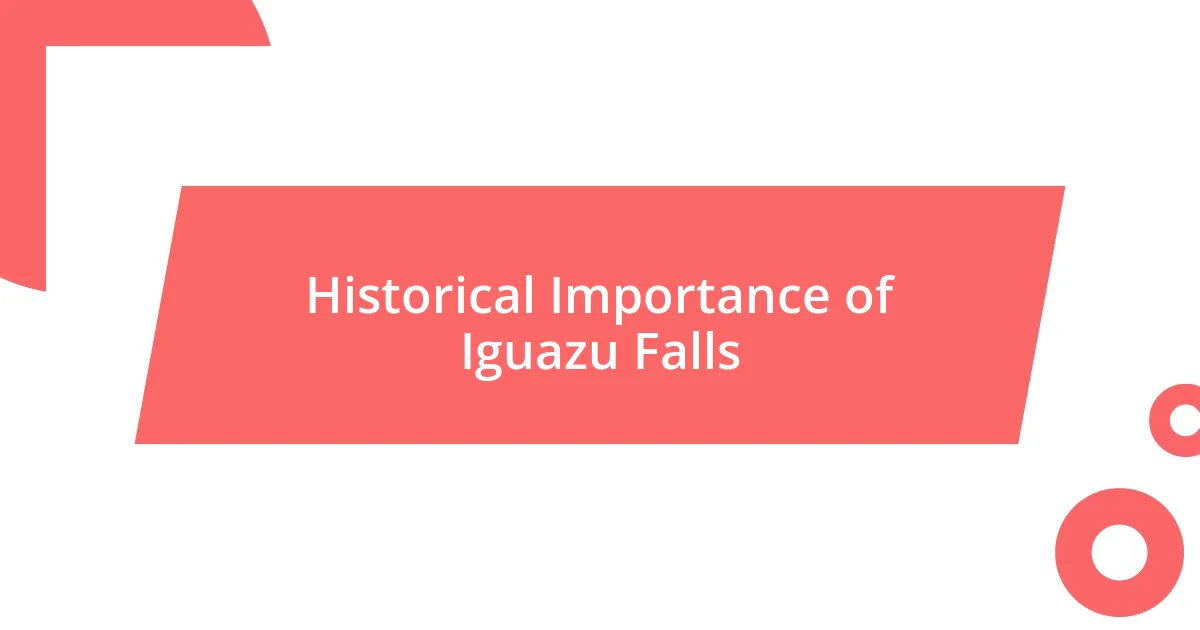
Historical Importance of Iguazu Falls
The historical significance of Iguazu Falls stretches back centuries and weaves a complex tapestry of indigenous cultures and early explorers. I remember reading about the Guarani people, who revered the falls, believing they were sacred and intertwined with their mythology. Their legends spoke of a serpent god who created the falls as a testament to both beauty and power. This connection between the landscape and the Guarani culture resonated deeply with me during my visit, as I felt the spiritual vibrancy surrounding the falls.
- In 1541, Spanish explorer Álvar Núñez Cabeza de Vaca became one of the first Europeans to document the falls, marking the beginning of a new era of exploration.
- Over time, Iguazu Falls emerged as a symbol of resistance and resilience, particularly during the tumultuous times of colonialism.
- The falls played a role in the border disputes between Brazil and Argentina, influencing political dynamics and territorial claims in the region.
- Today, the significance of the falls is recognized internationally, as they were designated a UNESCO World Heritage Site in 1984, highlighting their cultural and environmental importance.
Thinking about these historical layers, I couldn’t help but feel a sense of connection to both the past and the present—how the stories of those who came before us continue to shape our understanding of this majestic natural wonder.

Natural Beauty and Biodiversity
The lush surroundings of Iguazu Falls are a vibrant ecosystem teeming with life. As I wandered through the rainforest paths, I felt like I’d stumbled upon a treasure trove of biodiversity. Can you imagine standing amidst trees that embody centuries of growth, while colorful butterflies dance around you? This biodiversity is not just a backdrop; it’s essential for the ecological balance of the area. Each species, from the ferns to the jaguars, plays a role in maintaining the health of the rainforest, making this a crucial habitat for countless plants and animals.
What struck me the most was the contrast in the landscape. One moment, I was standing at the brink of the thundering falls, feeling vibrated by the roar of the water, and the next, I was surrounded by delicate orchids peeking out from the underbrush. The sheer variety of life is astounding, with over 2,000 plant species and countless animal species, including endangered ones like the South American tapir. Seeing these creatures in their natural habitat made me appreciate the importance of conservation efforts. After all, how often do we get to see ecosystems so vivid and alive?
Iguazu Falls is not only a visual marvel; it embodies the delicate balance of nature. My experience there taught me that the beauty of our planet encompasses not just breathtaking views but also the intricate web of life that thrives within it. It’s a poignant reminder of our responsibility to protect such places. Have you considered the significance of preserving these precious ecosystems for future generations?
| Aspect | Details |
|---|---|
| Flora Diversity | Over 2,000 plant species including ferns and orchids. |
| Fauna Diversity | Home to endangered species such as the South American tapir. |
| Conservation Significance | Essential for ecological balance and biodiversity preservation. |
| Unique Ecosystems | Interplay between waterfalls and rainforest contributes to diverse habitats. |
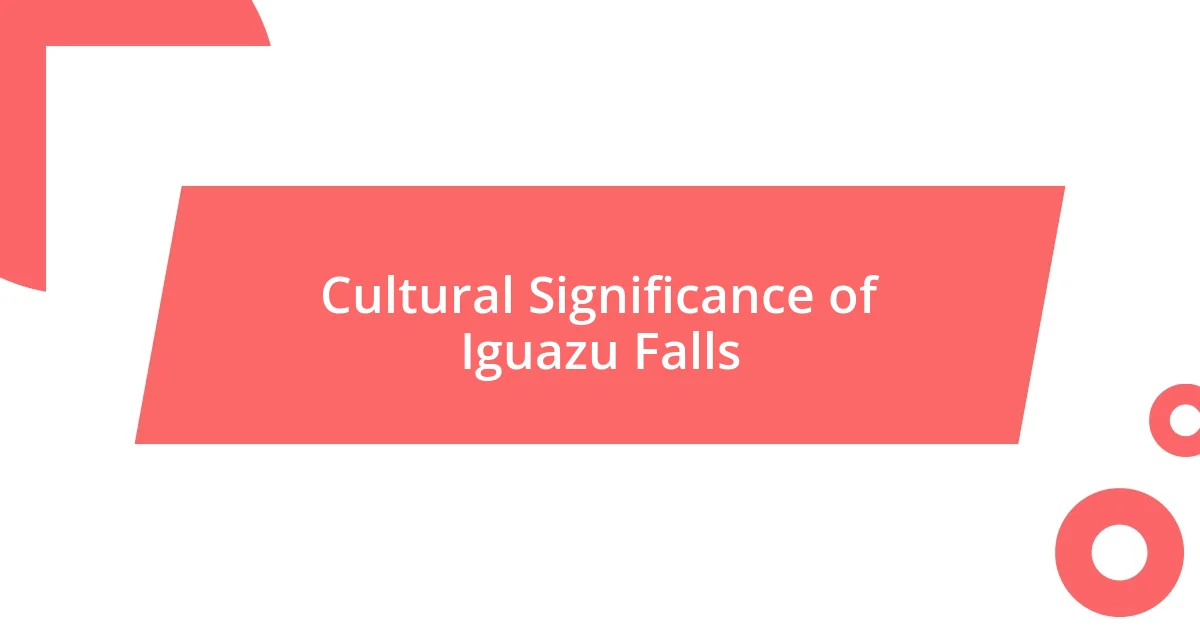
Cultural Significance of Iguazu Falls
The cultural significance of Iguazu Falls is deeply interwoven with the identity of the Guarani people, whose stories breathe life into the landscape. I remember standing at the edge of the falls, and it felt as if I could almost hear the whispers of their ancestors echoing through the mist. Their myths, steeped in reverence, portray the falls not just as a stunning natural feature, but as a living entity—infused with the spirit of their serpent god. In that moment, I understood how this place wasn’t merely a backdrop for adventure; it was a sacred space that shaped their culture and values.
Moreover, the falls have attracted artists, writers, and musicians who find inspiration in its beauty and power. I can’t help but think of how many creations, from poetry to paintings, have sprung from the sheer awe that this natural wonder evokes. Have you ever experienced a place that stirred such creativity within you? That’s what Iguazu Falls does; it ignites the imagination, connecting people across different backgrounds and eras through art and storytelling.
Today, as we recognize Iguazu Falls as a UNESCO World Heritage Site, there’s a collective responsibility to honor and preserve its cultural significance. During my visit, I saw travelers from around the world united by their admiration for the falls, reminding me that its impact transcends borders. Isn’t it fascinating how a natural wonder can inspire a global sense of stewardship that revolves around cultural appreciation as much as environmental protection? As I walked those trails, I couldn’t shake the feeling that I was part of something greater—a shared legacy that must be cherished and protected for future generations.

Tourism Impact on Local Communities
As I observed the bustling energy of the local markets, I couldn’t help but notice how tourism had visibly transformed the community. Small businesses thrived due to the influx of visitors, with locals selling handmade crafts and traditional food. This interaction not only provided a source of income but also fostered a sense of pride in their cultural heritage. Have you ever tasted a local dish that offered a glimpse into a place’s history? It’s exhilarating to think about how these experiences intertwine local culture with tourism.
However, this boom in tourism doesn’t come without some challenges. I encountered some locals who expressed concern over the environmental impact and the commercialization of their traditions. The balance between preserving authenticity while catering to tourist demands seems delicate. It made me ponder: can we truly appreciate a culture while altering it for our benefit? I believe open dialogue between tourists and locals is essential to ensure that cultural integrity is maintained in the face of progress.
Interestingly, during a community event I attended, I saw how tourism could unite people. Visitors and locals came together in celebration, sharing stories and laughter. This camaraderie created a powerful connection and reminded me that, ultimately, the impact of tourism on local communities is complex. It’s about fostering mutual respect and understanding to create an exchange that benefits everyone involved. Have you ever felt that sense of community while traveling? It truly enriches the experience, doesn’t it?
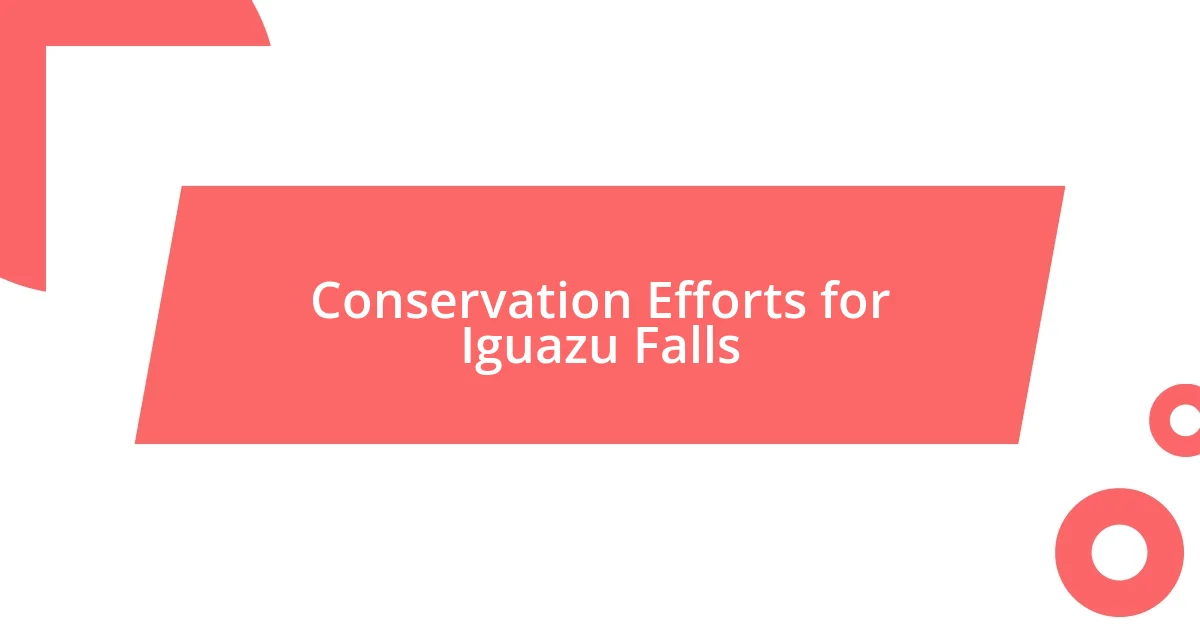
Conservation Efforts for Iguazu Falls
I was struck by how devoted conservation efforts are at Iguazu Falls, balancing tourism and environmental preservation. During my visit, I participated in a reforestation initiative, planting trees alongside local volunteers. It felt empowering to contribute, and I realized that these hands-on efforts are vital for maintaining the lush ecosystem surrounding the falls. Have you ever been involved in a project that made you feel connected to a place? It truly deepens your appreciation for such breathtaking natural wonders.
In addition to reforestation, education is a crucial part of the conservation strategy here. I attended a workshop aimed at teaching visitors about the local flora and fauna. It was fascinating to hear about the unique species that thrive in this environment and how vital they are for the ecosystem’s health. This knowledge encourages tourists to respect and protect the area, transforming their admiration into action. Don’t you think that understanding a place often enhances our desire to safeguard it?
Moreover, partnerships between government and private organizations play a significant role in conservation efforts. I learned that funding for maintenance and research comes from a mix of sources, which helps tackle the challenges posed by climate change and increasing tourist numbers. Witnessing this collaborative spirit was inspiring; it reminded me that effective conservation is often a community effort. Could there be a greater testament to human ingenuity than the desire to protect something as magnificent as Iguazu Falls? I believe our commitment to preserving such iconic habitats is essential for future generations to experience their beauty and magic.

Personal Reflections on Iguazu Experience
My reflections on my experience at Iguazu Falls are filled with awe and gratitude. Standing at the edge of the falls for the first time, I felt a rush of emotions—the sound of cascading water mingling with the breathtaking vistas ignited a sense of wonder that’s hard to articulate. Have you ever found yourself so captivated by nature that time seemed to stand still? That was my moment, as I absorbed the sheer power and beauty of Iguazu.
I also recall a humbling encounter with a park ranger who shared his passion for the falls. Listening to his stories about the flora and fauna, I realized how intertwined the local culture is with this natural wonder. It made me reflect: how often do we overlook the stories behind the landscapes we admire? That day, I promised myself to delve deeper into the narratives of nature, appreciating not just the sights, but the lives that exist within the shadows of those majestic waterfalls.
As I explored the trails surrounding Iguazu, I couldn’t shake the feeling that I was part of something bigger. The vibrant wildlife and lush greenery around me made my heart swell with an appreciation for the interconnectedness of life. How does it feel, I wondered, to stand on sacred ground where nature’s artistry has been sculpted over millennia? It’s an experience that compels me to advocate for its preservation; another reminder of how fleeting and precious these natural treasures truly are.




